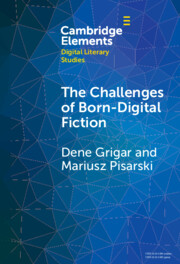Element contents
The Challenges of Born-Digital Fiction
Published online by Cambridge University Press: 21 February 2024
Summary
- Type
- Element
- Information
- Online ISBN: 9781009181488Publisher: Cambridge University PressPrint publication: 21 March 2024
References
Primary Sources
Secondary Sources
- 5
- Cited by

